| KIT # | 4811 |
| PRICE: | $39.95 MSRP |
| DECALS: | two options (sorta; it is two planes from the same unit |
| REVIEWER: | Scott Van Aken |
| NOTES: | Short run with resin bits |
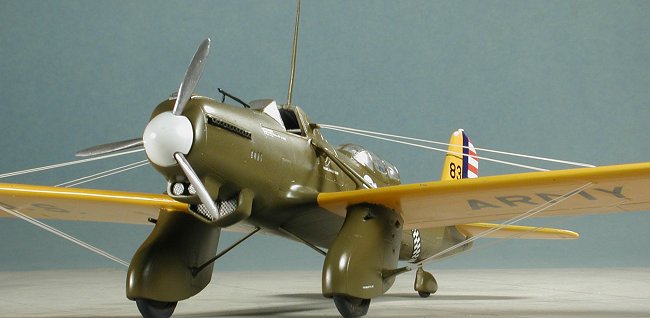
Czech Model 1/48 A-8 Shrike
| KIT # | 4811 |
| PRICE: | $39.95 MSRP |
| DECALS: | two options (sorta; it is two planes from the same unit |
| REVIEWER: | Scott Van Aken |
| NOTES: | Short run with resin bits |

| BACKGROUND |
Please visit the preview for a look at what is in the box.
| CONSTRUCTION |
Not wanting to sound trite, but I almost started with the interior! Actually, I started by removing resin bits from the various pour stubs. Most of them could be removed with a sharp scalpel blade, but some, like the seats, exhaust and radiator had to be sawn. The radiator is particularly tricky as you have to cut a 'vee' out of the upper portion while leaving the side portions tall enough to fit in the slots on the fuselage nose. I did this portion rather carefully, test fitting it many times to be sure it fit properly.
 Once that was done, I started gluing parts together. Since the interior is basically aluminum (not much in the way of cockpit lighting so a bright cockpit was preferred), I assembled much of the interior portions, including one sidewall. The aft floor on my kit was not well molded with sections of the floor being particularly 'soft', as if there wasn't enough resin. There are small 'vee' braces that go in the forward cockpit, but the instructions are not very forthcoming on exactly how these bits are supposed to fit other than showing them attached near the top of the cockpit walls. I left them off while I painted all the interior parts with Alclad II aluminum. What appears to be a fuel tank with a brace topped by an airfoil section is a bit tricky to install and is one of those bits that 'only fits where it touches'! I detail painted some of the boxes and forward instrument panel in black and then gave the entire interior a wash of dirty thinner. Thanks to Alclad II being a lacquer, the dirty enamel thinner did not harm the aluminum paint at all. Seat belts were painted khaki as per the instructions. I then drybrushed the black bits to bring out what little detail there is.
Once that was done, I started gluing parts together. Since the interior is basically aluminum (not much in the way of cockpit lighting so a bright cockpit was preferred), I assembled much of the interior portions, including one sidewall. The aft floor on my kit was not well molded with sections of the floor being particularly 'soft', as if there wasn't enough resin. There are small 'vee' braces that go in the forward cockpit, but the instructions are not very forthcoming on exactly how these bits are supposed to fit other than showing them attached near the top of the cockpit walls. I left them off while I painted all the interior parts with Alclad II aluminum. What appears to be a fuel tank with a brace topped by an airfoil section is a bit tricky to install and is one of those bits that 'only fits where it touches'! I detail painted some of the boxes and forward instrument panel in black and then gave the entire interior a wash of dirty thinner. Thanks to Alclad II being a lacquer, the dirty enamel thinner did not harm the aluminum paint at all. Seat belts were painted khaki as per the instructions. I then drybrushed the black bits to bring out what little detail there is.
While all this was drying, I added the exhaust to the inside of the nose. There is no alignment help for these at all and getting them in any kind of a even fit was a real chore. In fact, I found it quite difficult and had to settle on getting them both as even as I could. Two barrel shaped oil coolers fit into the outer parts of a housing under the nose. Frankly, I think it looks a tad odd with the gap between them and perhaps these should either be larger or the opening narrower.
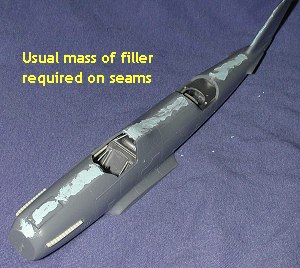 Next step was putting in the 'cover' over the aft cockpit and then gluing the other side panel in place. Test fitting showed no problems there. Can't say the same on the front. It turned out to be too wide so I had to do some sanding and carving to get it to fit in place. I think it is a tad low but without any references, don't know for sure. I did manage to fit those 'vee' braces in the cockpit without too much trouble. The instrument panel fits atop the resin cockpit and that had to be trimmed down to get it to fit well enough to where I could close the fuselage halves. This was relatively painless except for the nose section, where I had to use superglue and clamp it for a while to get the halves to mate. As usual, there were large seams that needed filled, even after I did some preliminary filing.
Next step was putting in the 'cover' over the aft cockpit and then gluing the other side panel in place. Test fitting showed no problems there. Can't say the same on the front. It turned out to be too wide so I had to do some sanding and carving to get it to fit in place. I think it is a tad low but without any references, don't know for sure. I did manage to fit those 'vee' braces in the cockpit without too much trouble. The instrument panel fits atop the resin cockpit and that had to be trimmed down to get it to fit well enough to where I could close the fuselage halves. This was relatively painless except for the nose section, where I had to use superglue and clamp it for a while to get the halves to mate. As usual, there were large seams that needed filled, even after I did some preliminary filing.
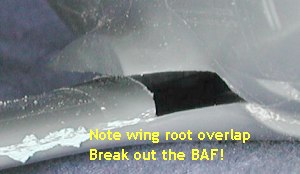 I then glued the wing halves together and filled the gaps that were there after sanding. Then I tried to fit the wings and fuselage together. Either the fuselage is too wide or the upper wings too long. I ended up sanding a bit off each of them. I had to use a BAF (Big *ss File) on the wing roots to get them narrowed down to where the wings would fit. This plane has very long wings in comparison to the fuselage! I then glued the wings in place and propped it up hoping that I'd be able to get some dihedral on them when the glue dries!
I then glued the wing halves together and filled the gaps that were there after sanding. Then I tried to fit the wings and fuselage together. Either the fuselage is too wide or the upper wings too long. I ended up sanding a bit off each of them. I had to use a BAF (Big *ss File) on the wing roots to get them narrowed down to where the wings would fit. This plane has very long wings in comparison to the fuselage! I then glued the wings in place and propped it up hoping that I'd be able to get some dihedral on them when the glue dries!
The gap on the wing root was such that it took several coats of filler to fill and to smooth out. With that done, the tail planes were glued in place. Fit there was not bad, but I did need a touch of filler. Then I moved to the underside of the 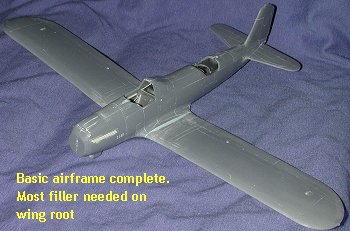 aircraft. First, I glued the wheel pants together, trapping the resin wheels between them. I had to slightly enlarge the holes for the small stub axles to get them both in place. They do turn and that will make it easier to paint them, though I'll have to go in stages. Yes, I should have pre-painted them, but I didn't. I used no filler on the wheel pant seams.
aircraft. First, I glued the wheel pants together, trapping the resin wheels between them. I had to slightly enlarge the holes for the small stub axles to get them both in place. They do turn and that will make it easier to paint them, though I'll have to go in stages. Yes, I should have pre-painted them, but I didn't. I used no filler on the wheel pant seams.
When it came to installing them, though, things were not quite as rosy. I had to file them so that the attachment angle would be such that they would be perpendicular to the ground. I think I got it pretty close, but it did call for filler when done. The placement instructions don't match the kit in terms of where they go. There is no engraved guide, which would have been helpful. I glued one on where the instructions showed and it seemed awful close to the fuselage. I pulled it off and chose a majo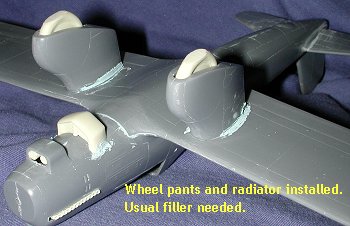 r panel line just outside where the instructions suggested and lined the pants up with that. It looks a LOT better. I also glued in the large radiator. This part is a bit narrower than the kit at that point so I had to do some creative carving to get it to fit. Again, I had to use filler to take care of the rather large gaps created on the outside edges of this part.
r panel line just outside where the instructions suggested and lined the pants up with that. It looks a LOT better. I also glued in the large radiator. This part is a bit narrower than the kit at that point so I had to do some creative carving to get it to fit. Again, I had to use filler to take care of the rather large gaps created on the outside edges of this part.
Once the gaps were filled on this and the radiator, I had to decide what to do about rigging. Frankly, a plane like this just doesn't look right without it, though I wasn't sure I was going to mess with the spreader bars. I filed flat the ends of the lower wire attachment housing and drilled four small holes into the ends using a #78 drill bit (.016 inches). These were then glued onto the wheel pants. On the top, things aren't as easy. These attachment fairings are resin and too small for the drill bit I was using. The only real option here is a butt fit. I then drilled out the holes in the wing where these wires would go, angling them towards the attachment fairings as I drilled, again, using the #78 bit.
| COLORS AND MARKINGS |
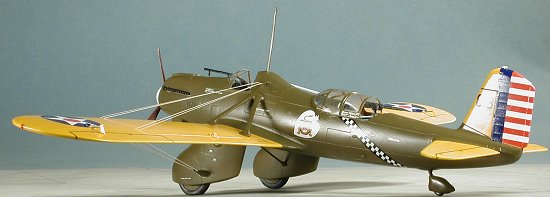 Then it was time for some paint. I used Polly Scale acrylics for this one as there was going to be no detail spraying needed and Polly Scale has a selection of prewar colors. In this case, Yellow 04 and Olive Drab 22. The first step was to undercoat all the yellow areas with white. I used Floquil Reefer white for this as it gives good coverage and dries quickly. Then it was followed by two coats of Yellow 04. I thinned this and the OD 22 with Future to add some sheen to it as I didn't want a totally flat finish. I didn't get that much of a sheen, but it was better than dead flat.
Then it was time for some paint. I used Polly Scale acrylics for this one as there was going to be no detail spraying needed and Polly Scale has a selection of prewar colors. In this case, Yellow 04 and Olive Drab 22. The first step was to undercoat all the yellow areas with white. I used Floquil Reefer white for this as it gives good coverage and dries quickly. Then it was followed by two coats of Yellow 04. I thinned this and the OD 22 with Future to add some sheen to it as I didn't want a totally flat finish. I didn't get that much of a sheen, but it was better than dead flat.
After that dried, I sprayed on the Future over it and let it dry. Then ALL the yellow was masked. It took quite a bit of tape, but the only way to ensure that there are no overspray problems is to mask everything. Then the OD 22 was sprayed on. This took several coats as I wanted to get all of the wheels painted as well so had to paint a section, let it dry, spin the wheel, and paint some more. I also painted the spinner white at this time.
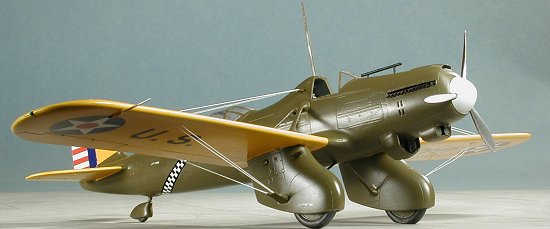 Then the kit was taken back to the workbench to have the canopies installed. There are two of them supplied so that if you make a goof, there's a second one available. I cut these out by scribing along the outer edges of the canopy and simply snapping them from the backing. I then masked them and when that was done, glued them into place. The forward windscreen needed a touch of additional trimming, but fit with no real problems. The aft canopy is much larger and I found it to be a bit oversize. In order for the back part to fit within the confines of the fuselage, I had to squeeze it a bit while the superglue dried. This meant that the forward section had large gaps. I glued this area down best as I could then when it was dry, I did several applications of white glue to fill in the gaps as best I could. The end result is not bad, especially for me. The tail wheel assembly was glued and cleaned up.
Then the kit was taken back to the workbench to have the canopies installed. There are two of them supplied so that if you make a goof, there's a second one available. I cut these out by scribing along the outer edges of the canopy and simply snapping them from the backing. I then masked them and when that was done, glued them into place. The forward windscreen needed a touch of additional trimming, but fit with no real problems. The aft canopy is much larger and I found it to be a bit oversize. In order for the back part to fit within the confines of the fuselage, I had to squeeze it a bit while the superglue dried. This meant that the forward section had large gaps. I glued this area down best as I could then when it was dry, I did several applications of white glue to fill in the gaps as best I could. The end result is not bad, especially for me. The tail wheel assembly was glued and cleaned up.
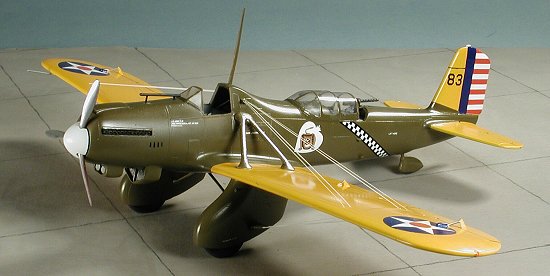 The kit then had the cockpit areas remasked to keep overspray out of it and then repainted the areas around the canopies. At this time, the tail wheel assembly and the upper and lower braces were painted as well. When all was dry, more Future was applied. Returning to the workbench, the braces had to be glued in place. Fit here is not the best and I had to fill gaps, especially in the upper brace. Because I moved the spats out a bit, the spat braces were a tad shorter than normal, but no real problem. During all this, one of the resin wheel axles broke off, leaving me a wheel that flopped around in the spat. Not good! I had to superglue the wheel in place as otherwise it would have ridden quite low on one side.
The kit then had the cockpit areas remasked to keep overspray out of it and then repainted the areas around the canopies. At this time, the tail wheel assembly and the upper and lower braces were painted as well. When all was dry, more Future was applied. Returning to the workbench, the braces had to be glued in place. Fit here is not the best and I had to fill gaps, especially in the upper brace. Because I moved the spats out a bit, the spat braces were a tad shorter than normal, but no real problem. During all this, one of the resin wheel axles broke off, leaving me a wheel that flopped around in the spat. Not good! I had to superglue the wheel in place as otherwise it would have ridden quite low on one side.
Now for the decals. I started with the tail stripes which are not exactly the same shape as the rudder. This is quite clear on the bottom where one must overlap a bit onto the painted area near the forward section with the decal to get it to fit properly. The wing stars are slightly off register and there is a sliver of white that peeks from the edge. I trimmed these as best as I could, but you may wish to inspect yours and replace them with aftermarket insignia. I didn't as the blue on these is a lighter shade than any of the aftermarket ones I have and they wouldn't have matched the rudder markings.
| FINAL ASSEMBLY |
With the kit painted and decaled (at least mostly decaled), I brought it back to the workbench for final assembly. On this kit that means quite a bit of work to go. Specifically, rigging this beastie. For some, this will pose no problem. For me, it wasn't that bad, but was very time consuming. I chose the stretched sprue route and used AMT sprues as their plastic stretches well (I have a stash from older AMT kits I've built in the past). If you recall. I drilled holes for most of the sprue attachment 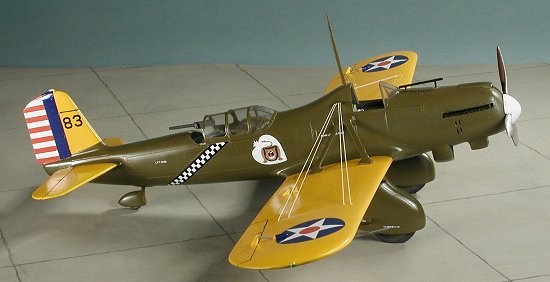 points and that helped quite a bit. Using white glue as the adhesive of choice (that way, if I totally screw one up, I can easily remove the offending bit and not have to redrill), I started on the bottom. First attaching the sprue into the spats, I worked in pairs. I trimmed the sprue to close to the actual size and then slipped them in the wing holes, applying and then smoothing out the white glue. I moved to the next pair and did the same. Once that pair was done, I returned to the first set (which had now dried) and, taking a match, struck it, let it burn a while and then blew it out. I passed the hot match head under the sprue and they tightened up once they got hot. Don't know why plastic does this, but it does and it makes things SO much nicer for us all.
points and that helped quite a bit. Using white glue as the adhesive of choice (that way, if I totally screw one up, I can easily remove the offending bit and not have to redrill), I started on the bottom. First attaching the sprue into the spats, I worked in pairs. I trimmed the sprue to close to the actual size and then slipped them in the wing holes, applying and then smoothing out the white glue. I moved to the next pair and did the same. Once that pair was done, I returned to the first set (which had now dried) and, taking a match, struck it, let it burn a while and then blew it out. I passed the hot match head under the sprue and they tightened up once they got hot. Don't know why plastic does this, but it does and it makes things SO much nicer for us all.
I worked this way until all the lower (and shorter) wires were done. You will notice that I weaseled out of doing the spreader bars as I'd be totally hopeless with them. I broke as many as I attached so once they were in place, I handled the model as if it was made of spun glass! The upper wires were a bit different. No holes as the attachment area was too small. Instead, I cut some sprue to length and then applied superglue to the ends of the attachment pylons. Carefully attaching the sprue, I put all four in place at the same time. Then when it was dry, I inserted the other ends into the predrilled holes in the wing using white glue and then did the match trick to tighten them up when dry. When the sprue broke on the upper wing, repair was much more difficult as I had to not only remove the old sprue, but scrape away a tiny area for the new one to be attached.
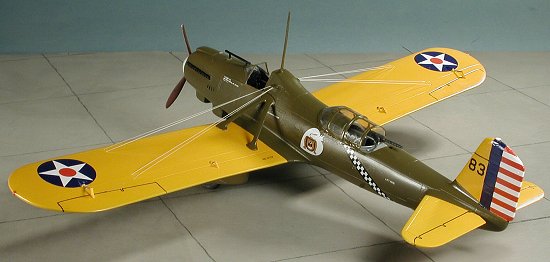 Finally, all of them were on and tight and they looked good. I decided not to paint them for fear of breaking more in the process, but the light grey doesn't look too bad. Now to glue on a bunch more little resin bits. First were the two tiny steps for the rear cockpit. Then I removed and installed the aileron and flap actuator linkage. I broke one of these, but after repair, it was in place and I gingerly moved on to the next. There are spat gun barrels supplied, but they look nothing like gun barrels. In fact, not only do they look too short (one is tiny), but they have no detail. Simply angled rod. I drilled out the long ones and then glued them in place. Trying to put the really teeny ones on as well was futile as I could barely hold them in the tweezers. So rather than frustrate myself, my A-8 only has one gun installed in each spat! Moving to the back, there is a gun for the radio operator. This also has a bit of a mount and it is supposed to have a separate resin handle. Well, I couldn't find it anywhere. Either I lost it or it wasn't there in the first place as I really don't remember seeing it. This gun and the spat guns were painted gun metal and the aft gun and mount was glued in place. I trimmed the post on the bottom of the rear gun before gluing it to its mount as it seemed way too tall with it.
Finally, all of them were on and tight and they looked good. I decided not to paint them for fear of breaking more in the process, but the light grey doesn't look too bad. Now to glue on a bunch more little resin bits. First were the two tiny steps for the rear cockpit. Then I removed and installed the aileron and flap actuator linkage. I broke one of these, but after repair, it was in place and I gingerly moved on to the next. There are spat gun barrels supplied, but they look nothing like gun barrels. In fact, not only do they look too short (one is tiny), but they have no detail. Simply angled rod. I drilled out the long ones and then glued them in place. Trying to put the really teeny ones on as well was futile as I could barely hold them in the tweezers. So rather than frustrate myself, my A-8 only has one gun installed in each spat! Moving to the back, there is a gun for the radio operator. This also has a bit of a mount and it is supposed to have a separate resin handle. Well, I couldn't find it anywhere. Either I lost it or it wasn't there in the first place as I really don't remember seeing it. This gun and the spat guns were painted gun metal and the aft gun and mount was glued in place. I trimmed the post on the bottom of the rear gun before gluing it to its mount as it seemed way too tall with it.
Moving to the front, I painted the back of the prop a maroon color and then glued it into the spinner. I had to enlarge the hole in the nose quite a bit to get the prop shaft in place. To my eyes, the prop seems t o be too small, but perhaps it was the norm for an engine that only produced about 600 hp. I was feeling really proud of myself when I noticed I'd forgotten the pitot tube and some of the stencil decals. Those were quickly glued on/applied and the the kit was nearly done. Looking in the box, I noticed the tall radio mast. Now you might want to make a new one. Mine was a bit warped and not at all straight, but I did glue it in place atop the fuselage. Also glued on was the gun sight, which was painted black. I then went and touched up all the areas that needed painted, like the resin bits I'd installed. A misting of Future was then applied and I used a tiny bit of pastels for minor exhaust stains. Since money was so tight in the 20's and 30's, a lot of time was spent cleaning up aircraft and they were generally in pristine condition, so grunge was not allowed! I then removed the masking from the clear bits. Using acrylics has its problems in that it doesn't stick as well as enamels so I had to do some touchup painting on the clear bits where the paint had come up with the masking. Finally, the kit was finished!
o be too small, but perhaps it was the norm for an engine that only produced about 600 hp. I was feeling really proud of myself when I noticed I'd forgotten the pitot tube and some of the stencil decals. Those were quickly glued on/applied and the the kit was nearly done. Looking in the box, I noticed the tall radio mast. Now you might want to make a new one. Mine was a bit warped and not at all straight, but I did glue it in place atop the fuselage. Also glued on was the gun sight, which was painted black. I then went and touched up all the areas that needed painted, like the resin bits I'd installed. A misting of Future was then applied and I used a tiny bit of pastels for minor exhaust stains. Since money was so tight in the 20's and 30's, a lot of time was spent cleaning up aircraft and they were generally in pristine condition, so grunge was not allowed! I then removed the masking from the clear bits. Using acrylics has its problems in that it doesn't stick as well as enamels so I had to do some touchup painting on the clear bits where the paint had come up with the masking. Finally, the kit was finished!
| CONCLUSIONS |
The kit took a lot more time to build than I'd originally thought. The fit of the resin was average, but not great and as a result, I had some problems. Were I to do another, I'd not use the resin wheels so I wouldn't have to worry about breaking the axles. I'd also try to figure out a way to drill holes in the upper wire braces as butt joining the wires is However, that is all hindsight. The finished model looks really great and it isn't really so difficult that it can't be done by a competent modeler. It is the first between wars 1/48 US Army model I've done in over a decade and I'm quite happy with the results. I'm hoping that this one does well so that they can bring out an A-12 and if we are lucky, an A-17, then A-18..... December 2003
Copyright ModelingMadness.com. All rights reserved.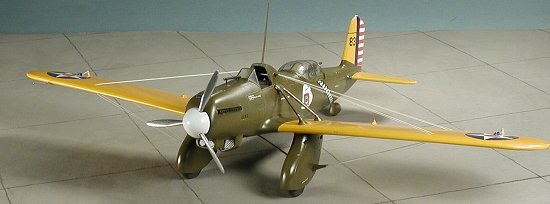 a real pain. I'd also hunt up some other gun barrels for the spats and predrill the holes for them. It would look a LOT better.
a real pain. I'd also hunt up some other gun barrels for the spats and predrill the holes for them. It would look a LOT better.
#1296 in a series
If you would like your product reviewed fairly and fairly quickly, please contact the editor or see other details in the